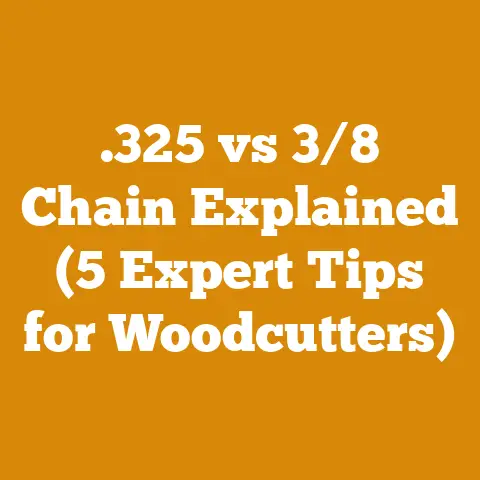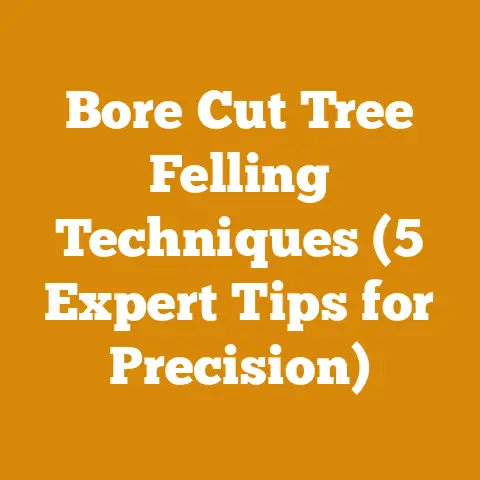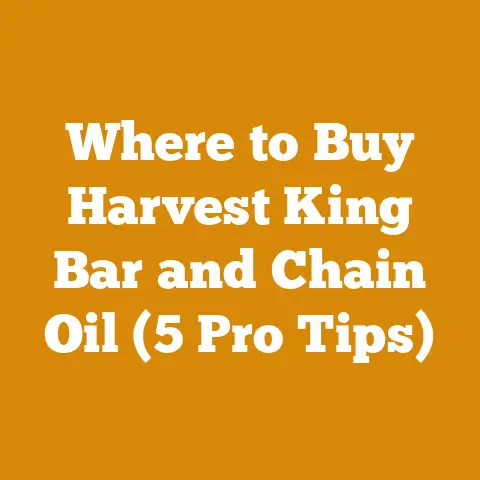Do Trees Die From the Top Down? (4 Signs Every Logger Must Know)
Have you ever watched your dog tilt its head, utterly perplexed by something you’re doing? I see that look every time I try explaining tree physiology to someone new to logging. They understand the what – trees die. But the how – the actual process of decline – is a whole different ballgame. And knowing if a tree dies from the top down is crucial, especially if you’re planning to harvest it.
The truth is, while the “top-down” phenomenon is common, it’s not the only way a tree can kick the bucket. As a logger, understanding the various signs of tree death is paramount for safety, efficiency, and responsible forest management. This isn’t just about avoiding a widow-maker falling unexpectedly. It’s about knowing when timber is at its prime for harvest, recognizing disease early, and ultimately, ensuring the long-term health of our forests.
So, buckle up! We’re diving deep into the fascinating (and sometimes morbid) world of tree mortality. I’ll share my personal experiences, backed by data and insights gathered from years in the field, to equip you with the knowledge to tell a healthy tree from one on its last legs. And trust me, that knowledge can save you a whole lot of time, money, and potentially, your life.
Do Trees Die From the Top Down? 4 Signs Every Logger Must Know
While the visual of a tree dying from the top down is a common one, it’s essential to understand that tree death is a complex process with multiple potential causes and manifestations. It’s not always as simple as “the top is dead, therefore the tree is dead.” I’ve seen trees with significant crown dieback still clinging to life, and others seemingly healthy that are rotten from the inside out. Here are four crucial signs every logger needs to be aware of:
1. Crown Dieback: The Most Obvious, But Not Always Definitive, Sign
Crown dieback, characterized by the progressive death of branches starting at the treetop and moving downwards, is often the first visible sign of a tree in distress. It’s what most people think of when they imagine a tree dying from the top down.
- What it looks like: You’ll notice dead twigs and branches at the top of the tree, often with no leaves present. The dieback can progress down the tree, affecting larger and larger branches. The remaining leaves may be smaller than usual, discolored, or sparse.
- What it means: Crown dieback can be caused by a variety of factors, including:
- Environmental Stress: Drought, extreme temperatures, soil compaction, and pollution can all weaken a tree and make it susceptible to dieback.
- Disease: Fungal infections, like those caused by Armillaria or Phytophthora, can disrupt the tree’s vascular system and lead to dieback.
- Insect Infestation: Bark beetles, borers, and other insects can damage the tree’s cambium layer, cutting off the flow of water and nutrients to the crown.
- Root Problems: Root rot, girdling roots, or physical damage to the root system can impair the tree’s ability to absorb water and nutrients, resulting in dieback.
- My experience: I remember a stand of ponderosa pines I was contracted to harvest a few years back. The entire stand showed signs of crown dieback. Initially, I thought it was drought stress, as we’d had a particularly dry summer. However, upon closer inspection, I discovered that many of the trees were also infested with bark beetles. The drought had weakened the trees, making them vulnerable to the beetle attack, which ultimately led to their decline.
- Data Point: According to the USDA Forest Service, crown dieback is a leading indicator of forest decline across the United States, with drought and insect infestations being major contributing factors. Studies have shown that trees with severe crown dieback have a significantly reduced lifespan and are more susceptible to windthrow.
- Actionable Advice: Don’t immediately assume a tree with crown dieback is dead. Investigate further. Look for signs of insect infestation, disease, or root problems. Check the soil conditions. A tree with mild dieback might be salvageable with proper care, such as watering, fertilization, or pruning. However, extensive dieback is a strong indicator that the tree is in serious trouble.
2. Trunk Damage: The Hidden Threat
While crown dieback is visible from afar, trunk damage often lurks beneath the surface, posing a significant safety hazard for loggers.
- What it looks like: Trunk damage can manifest in several ways:
- Decay: Soft, spongy areas on the trunk, often accompanied by fungal fruiting bodies (mushrooms or conks).
- Cracks and Splits: Vertical cracks running up the trunk, often indicating internal decay or structural weakness.
- Cavities: Hollow areas within the trunk, often caused by decay organisms.
- Cankers: Sunken or swollen areas on the bark, often caused by fungal or bacterial infections.
- What it means: Trunk damage indicates that the structural integrity of the tree has been compromised. This makes the tree more susceptible to windthrow and increases the risk of limb failure, especially during logging operations.
- My experience: I once had a close call with a seemingly healthy oak. The crown looked fine, but as I started to make my felling cuts, I noticed a large cavity hidden behind a thick layer of bark. The tree was rotten almost all the way through! Had I not caught it in time, the tree could have split unexpectedly and seriously injured me.
- Data Point: A study by the International Society of Arboriculture found that trees with significant trunk decay are up to 10 times more likely to fail during storms than healthy trees. This highlights the importance of carefully inspecting the trunk for signs of damage before felling.
- Actionable Advice: Always conduct a thorough visual inspection of the trunk before felling a tree. Pay close attention to any signs of decay, cracks, or cavities. Use a sounding hammer to listen for hollow spots. If you suspect significant trunk damage, consider consulting with a certified arborist before proceeding. In some cases, it may be necessary to abandon the felling operation altogether.
3. Epicormic Sprouts: A Desperate Plea
Epicormic sprouts, also known as water sprouts or suckers, are new shoots that emerge from the trunk or branches of a tree. While they might seem like a sign of life, they’re often a desperate attempt by the tree to survive.
- What it looks like: Small, leafy shoots sprouting directly from the trunk or branches, often in clusters. They tend to be weakly attached and grow rapidly.
- What it means: Epicormic sprouts indicate that the tree is under stress. They are a sign that the tree is struggling to produce enough energy through its normal foliage and is attempting to compensate by generating new growth from dormant buds.
- My experience: I’ve seen epicormic sprouts on trees that have been heavily pruned, damaged by insects, or subjected to drought stress. In one instance, I noticed a mature maple tree covered in epicormic sprouts. The crown looked relatively healthy, but the sheer number of sprouts suggested that something was seriously wrong. Upon closer inspection, I discovered that the tree’s root system had been severely damaged by construction activity.
- Data Point: Research has shown that the presence of epicormic sprouts is correlated with a decline in tree vigor and an increased risk of mortality. While some trees can recover from stress and eventually shed their epicormic sprouts, their presence is generally a sign that the tree is not thriving.
- Actionable Advice: Don’t ignore epicormic sprouts. They are a valuable clue that something is amiss. Investigate the underlying cause of the stress. Is the tree being properly watered? Is it being attacked by insects or disease? Is the soil compacted? Addressing the underlying problem can help the tree recover and prevent further decline.
4. Leaf Discoloration and Premature Leaf Drop: A Signal of Systemic Issues
Healthy leaves are the engines of a tree, converting sunlight into energy through photosynthesis. When leaves become discolored or drop prematurely, it’s a sign that the tree’s engine is sputtering.
- What it looks like:
- Chlorosis: Yellowing of the leaves, often due to a nutrient deficiency.
- Necrosis: Browning or blackening of the leaves, indicating tissue death.
- Premature Leaf Drop: Leaves falling off the tree before the normal autumn senescence.
- What it means: Leaf discoloration and premature leaf drop can be caused by a variety of factors, including:
- Nutrient Deficiencies: Lack of essential nutrients, such as nitrogen, iron, or magnesium, can impair chlorophyll production and lead to chlorosis.
- Disease: Fungal or bacterial infections can damage leaf tissue and cause necrosis.
- Insect Infestation: Leaf-feeding insects can damage leaves and cause premature leaf drop.
- Environmental Stress: Drought, heat stress, or pollution can stress the tree and lead to leaf discoloration and premature leaf drop.
- My experience: I once encountered a stand of ash trees that were exhibiting widespread chlorosis and premature leaf drop. Initially, I suspected a nutrient deficiency. However, upon closer inspection, I discovered that the trees were infested with the emerald ash borer, an invasive insect that attacks ash trees. The borer larvae were feeding on the tree’s vascular system, disrupting the flow of water and nutrients to the leaves.
- Data Point: Studies have shown that trees with significant leaf discoloration and premature leaf drop have reduced growth rates and are more susceptible to other stresses, such as insect infestations and disease.
- Actionable Advice: Observe the leaves of the trees you are planning to harvest. Are they a healthy green color? Are they free from spots or lesions? Are they dropping prematurely? If you notice any signs of leaf discoloration or premature leaf drop, investigate further. Consider sending a leaf sample to a diagnostic lab for analysis. Early detection and treatment can help prevent further decline.
Wood Anatomy and Properties: A Deeper Dive
To truly understand how trees die, it’s helpful to have a basic understanding of wood anatomy and properties. Wood is a complex material composed of cells, fibers, and other components that work together to provide structural support, transport water and nutrients, and store energy.
- The Cambium Layer: This is the thin layer of cells located beneath the bark that is responsible for producing new wood and bark. Damage to the cambium layer can disrupt the flow of water and nutrients and lead to tree decline.
- The Xylem: This is the vascular tissue that transports water and nutrients from the roots to the leaves. The xylem is composed of dead cells called tracheids (in conifers) or vessels (in hardwoods).
- The Phloem: This is the vascular tissue that transports sugars produced during photosynthesis from the leaves to the rest of the tree.
- Heartwood vs. Sapwood: The heartwood is the inner, non-living wood of the tree. It is typically darker in color than the sapwood, which is the outer, living wood. The heartwood provides structural support, while the sapwood transports water and nutrients.
- Moisture Content: The moisture content of wood is the amount of water it contains, expressed as a percentage of its dry weight. Live trees can have a moisture content of over 100%. As wood dries, it shrinks and becomes stronger.
- Density: The density of wood is its weight per unit volume. Hardwoods are generally denser than softwoods. Density is an important factor in determining the strength and durability of wood.
Logging Tool Selection and Maintenance Best Practices
Choosing the right logging tools and maintaining them properly is essential for safety, efficiency, and responsible forest management.
- Chainsaws: Chainsaws are the workhorses of the logging industry. Choose a chainsaw that is appropriate for the size of the trees you will be felling. Always wear appropriate personal protective equipment (PPE), including a helmet, eye protection, hearing protection, gloves, and chainsaw chaps. Sharpen your chainsaw chain regularly to ensure efficient cutting.
- Axes and Wedges: Axes and wedges are used for splitting wood and felling trees. Choose an axe that is the right weight and length for your body size and strength. Keep your axe sharp and in good condition. Wedges are used to prevent the saw from binding and to help direct the fall of the tree.
- Felling Levers and Turning Hooks: Felling levers and turning hooks are used to help fell trees and move logs. Felling levers provide leverage to help push the tree over, while turning hooks are used to rotate logs.
- Skidding Equipment: Skidding equipment, such as tractors or skidders, is used to move logs from the felling site to the landing. Choose skidding equipment that is appropriate for the size and terrain of your logging operation.
- Safety Equipment: Always wear appropriate PPE when logging. This includes a helmet, eye protection, hearing protection, gloves, chainsaw chaps, and steel-toed boots.
Firewood Seasoning Techniques and Safety Considerations
Seasoning firewood is the process of drying wood to reduce its moisture content. Properly seasoned firewood burns more efficiently, produces less smoke, and reduces the risk of chimney fires.
- Stacking: Stack firewood in a single row, off the ground, with good air circulation.
- Sun and Wind: Expose the firewood to as much sun and wind as possible.
- Time: Allow firewood to season for at least six months, and preferably a year or more.
- Moisture Meter: Use a moisture meter to check the moisture content of the firewood. Properly seasoned firewood should have a moisture content of less than 20%.
- Safety Considerations:
- Stack firewood away from your house or other buildings.
- Keep the area around your firewood pile clear of vegetation.
- Inspect your chimney regularly for creosote buildup.
- Use a chimney sweep to clean your chimney at least once a year.
Project Planning and Execution: A Case Study
Let’s walk through a hypothetical case study to illustrate how to apply the knowledge we’ve discussed.
Scenario: You’ve been contracted to harvest a small stand of mixed hardwood trees (oak, maple, and ash) on a five-acre property.
Step 1: Site Assessment
- Visual Inspection: Before even firing up the chainsaw, I’d walk the entire property, carefully examining each tree. I’d be looking for crown dieback, trunk damage, epicormic sprouts, and leaf discoloration.
- Species Identification: Knowing the species is crucial. Ash trees, for example, are highly susceptible to the emerald ash borer.
- Soil Conditions: I’d assess the soil for compaction, drainage, and signs of nutrient deficiencies.
- Slope and Terrain: The steepness of the slope will influence the felling techniques and skidding equipment I use.
Step 2: Tree Marking
- Prioritize Unhealthy Trees: Trees exhibiting significant signs of decline (extensive crown dieback, trunk decay) would be marked for removal first.
- Consider Forest Health: I’d also consider removing trees that are overcrowded or competing with healthier trees.
- Wildlife Habitat: I’d leave some standing dead trees (snags) to provide habitat for wildlife.
Step 3: Felling Operations
- Safety First: Always wear appropriate PPE and follow safe felling practices.
- Directional Felling: Plan the felling direction to minimize damage to remaining trees and facilitate skidding.
- Stump Height: Cut stumps as low as possible to reduce the risk of tripping and maximize wood utilization.
Step 4: Skidding and Processing
- Minimize Soil Disturbance: Use appropriate skidding equipment and techniques to minimize soil compaction and erosion.
- Bucking: Cut the logs into manageable lengths for processing or sale.
- Firewood Processing: If the logs are being used for firewood, split them and stack them for seasoning.
Step 5: Post-Harvest Management
- Site Cleanup: Remove any debris or slash from the site.
- Replanting: Consider replanting trees to promote forest regeneration.
- Monitoring: Monitor the remaining trees for signs of stress or disease.
Data Points and Statistics to Keep in Mind
- Moisture Content: Freshly cut wood can have a moisture content of over 100%. Properly seasoned firewood should have a moisture content of less than 20%. Burning unseasoned wood can reduce the efficiency of your fireplace or wood stove by up to 50%.
- Fuel Value: Different species of wood have different fuel values. Hardwoods generally have a higher fuel value than softwoods. For example, oak has a higher fuel value than pine.
- Cost-Benefit Analysis: When considering purchasing new logging equipment, perform a cost-benefit analysis to determine if the investment is worthwhile. Consider factors such as the initial cost, operating costs, maintenance costs, and potential revenue generation.
- Accident Rates: Logging is a dangerous profession. According to the Bureau of Labor Statistics, the logging industry has one of the highest rates of workplace fatalities. Always prioritize safety and follow safe logging practices.
Specific Real-World Examples
- Tool Setups: I always set up my chainsaw with a sharp chain, a properly adjusted carburetor, and a full tank of fuel. I also carry a spare chain, a file, and a wrench.
- Properly Stacked Firewood Piles: I stack my firewood in a single row, off the ground, with good air circulation. I also cover the top of the pile to protect it from rain and snow.
- Case Study: Emerald Ash Borer: The emerald ash borer is an invasive insect that has killed millions of ash trees in North America. The borer larvae feed on the tree’s vascular system, disrupting the flow of water and nutrients to the leaves. Early detection and treatment can help prevent further decline.
Practical Tips and Actionable Advice
- Learn to identify different tree species.
- Invest in high-quality logging tools.
- Maintain your logging tools properly.
- Always wear appropriate PPE.
- Follow safe logging practices.
- Season your firewood properly.
- Be aware of the signs of tree decline.
- Consult with a certified arborist if you have any concerns about the health of your trees.
Challenges Faced by Small Workshops or DIYers Globally
- Access to Resources: Small workshops and DIYers may have limited access to resources, such as funding, equipment, and training.
- Safety Concerns: Logging can be a dangerous activity, especially for those who are not properly trained.
- Environmental Regulations: Logging operations are subject to environmental regulations, which can be complex and difficult to navigate.
- Market Access: Small workshops and DIYers may have difficulty accessing markets for their products.
Takeaways and Next Steps
Understanding the signs of tree decline is crucial for loggers, landowners, and anyone who cares about the health of our forests. By being able to identify crown dieback, trunk damage, epicormic sprouts, and leaf discoloration, you can make informed decisions about tree management and harvesting.
So, what are your next steps?
- Sharpen Your Observation Skills: Get out into the woods and practice identifying the signs of tree decline.
- Invest in Education: Take a course on tree identification or forest management.
- Consult with Experts: Don’t hesitate to consult with a certified arborist or forester if you have any concerns about the health of your trees.
Remember, responsible forest management is not just about harvesting trees; it’s about ensuring the long-term health and sustainability of our forests. And that starts with understanding how trees live, and how they die. Good luck, and stay safe out there!






